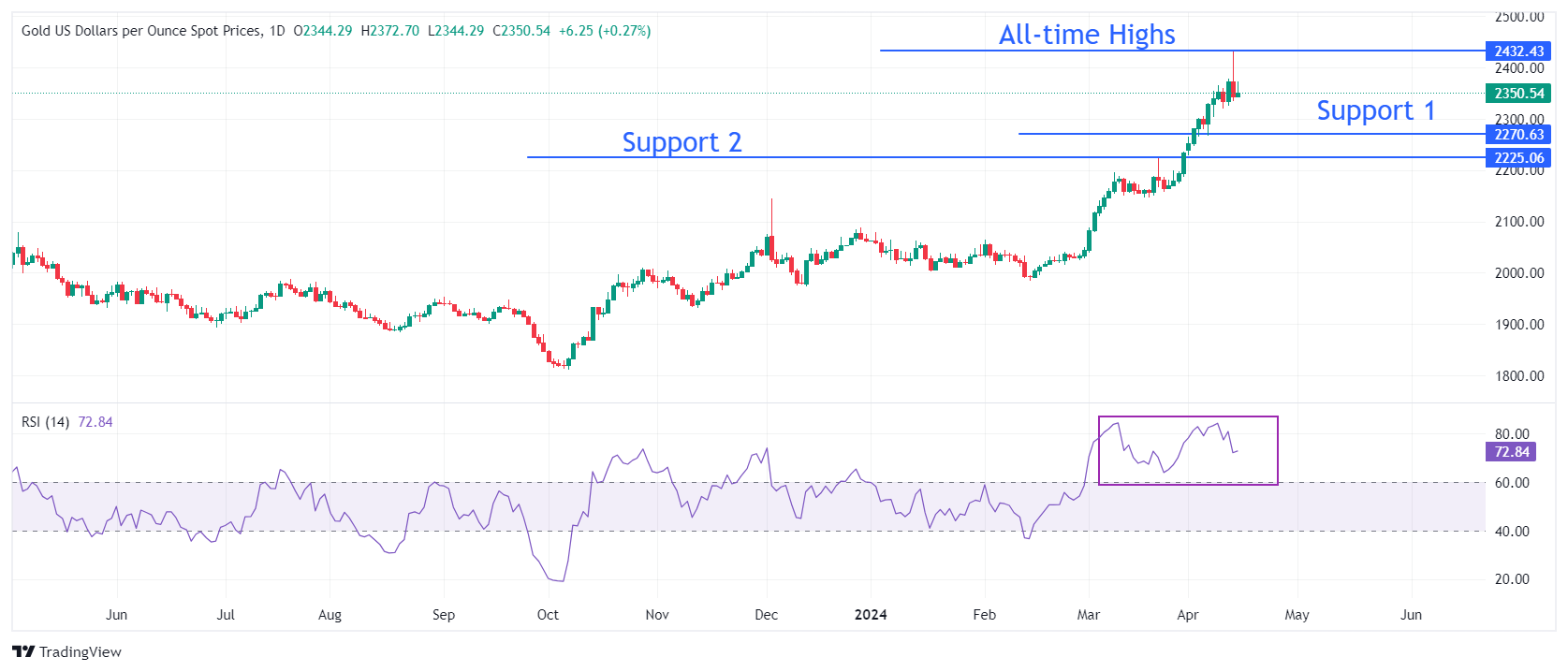- Gold price retreats from fresh highs near $2,430 as investors don’t see Middle East tensions escalating further.
- US bond yields soar as the Fed seems to initiate the rate cut cycle from September.
- The US Dollar exhibits strength on strong US Retail Sales data.
Gold price (XAU/USD) extends its downside to $2,330 in Monday’s early New York session. The precious metal loses shine in the very-short term as investors expect that geopolitical tensions will not escalate further. United States President Joe Biden said that his nation will not support the counterattack from Israel on Iran.
Receding Federal Reserve (Fed) rate cut bets for the June and July meetings, combined with less fears of further escalating Iran-Israel tensions, have put some pressure on Gold. Fed policymakers support keeping interest rates restrictive before they get convinced that inflation will return to the required rate of 2%
Meanwhile, stronger-than-expected monthly Retail Sales data for March has boosted bond yields and the US Dollar. The US Census Bureau reported that Retail Sales grew by 0.7%- the pace was more than double from expectations of 0.3%. In February, Retail Sales were up by 0.9%, upwardly revised from 0.6%. Robust spending by US households remains a major catalyst to higher inflation, allowing businesses to charge higher from consumers.
The 10-year US Treasury yields rally to 4.61%. Higher bond yields weigh on the Gold price as they increase the opportunity cost of holding an investment in it. The US Dollar Index (DXY), which tracks the US Dollar’s value against six major currencies, prints a fresh five-month high at 106.16.
Daily digest market movers: Gold price falls after robust US Retail Sales data
- Gold price consolidates after retreating from fresh all-time highs near $2,430 as investors see Iran’s air strike on the Israeli state only as a retaliation to the attack on their embassy in Syria near Damascus. Tensions between Iran and Israel are not expected to escalate further as Tehran said, “the matter deemed to be closed.” However, should the Israeli regime make another mistake, Iran’s response will be considerably more severe, the Wall Street Journal reported.
- The statement from the United States that it will not support the counterattack from Israel has boosted confidence among investors that Middle East tensions will not escalate further. Over the weekend, Iran launched hundreds of drones and missiles aimed at Israel.
- Meanwhile, uncertainty over the Federal Reserve (Fed) pivoting to rate cuts has weighed heavily on Gold. Financial markets have shifted their expectations for Fed rate cuts to the September meeting as the United States Consumer Price Index (CPI) report turned out hotter than expected in March.
- San Francisco Fed Bank President Mary Daly said on Friday that there is no urgency to reduce interest rates. Daly added that there is still more work to do to ensure that inflation is on course to return to the desired rate of 2%. She also emphasised keeping interest rates restrictive as long as inflation is necessary to return to the 2% target.
- Separately, Boston Fed Bank President Susan Collins said she hopes demand will start slowing and will support bringing down inflation later this year. Collins said she forecasted two rate cuts in the latest dot plot, in which most Fed members projected the central bank reducing interest rates three times by year-end.
Technical Analysis: Gold price drops from fresh highs near $2,430
Gold price corrects from new all-time highs formed around $2,430. The precious metal faces pressure as momentum oscillators are overheated. The 14-period Relative Strength Index (RSI) drops slightly after peaking around 85.00. The near-term demand is intact as the RSI remains in the bullish range of 60.00-80.00. However, momentum oscillators are cooling down after turning extremely overbought.
On the downside, April 5 low near $2,268 and March 21 high at $2,223 will be major support areas for the Gold price.
Fed FAQs
Monetary policy in the US is shaped by the Federal Reserve (Fed). The Fed has two mandates: to achieve price stability and foster full employment. Its primary tool to achieve these goals is by adjusting interest rates. When prices are rising too quickly and inflation is above the Fed’s 2% target, it raises interest rates, increasing borrowing costs throughout the economy. This results in a stronger US Dollar (USD) as it makes the US a more attractive place for international investors to park their money. When inflation falls below 2% or the Unemployment Rate is too high, the Fed may lower interest rates to encourage borrowing, which weighs on the Greenback.
The Federal Reserve (Fed) holds eight policy meetings a year, where the Federal Open Market Committee (FOMC) assesses economic conditions and makes monetary policy decisions. The FOMC is attended by twelve Fed officials – the seven members of the Board of Governors, the president of the Federal Reserve Bank of New York, and four of the remaining eleven regional Reserve Bank presidents, who serve one-year terms on a rotating basis.
In extreme situations, the Federal Reserve may resort to a policy named Quantitative Easing (QE). QE is the process by which the Fed substantially increases the flow of credit in a stuck financial system. It is a non-standard policy measure used during crises or when inflation is extremely low. It was the Fed’s weapon of choice during the Great Financial Crisis in 2008. It involves the Fed printing more Dollars and using them to buy high grade bonds from financial institutions. QE usually weakens the US Dollar.
Quantitative tightening (QT) is the reverse process of QE, whereby the Federal Reserve stops buying bonds from financial institutions and does not reinvest the principal from the bonds it holds maturing, to purchase new bonds. It is usually positive for the value of the US Dollar.
Information on these pages contains forward-looking statements that involve risks and uncertainties. Markets and instruments profiled on this page are for informational purposes only and should not in any way come across as a recommendation to buy or sell in these assets. You should do your own thorough research before making any investment decisions. FXStreet does not in any way guarantee that this information is free from mistakes, errors, or material misstatements. It also does not guarantee that this information is of a timely nature. Investing in Open Markets involves a great deal of risk, including the loss of all or a portion of your investment, as well as emotional distress. All risks, losses and costs associated with investing, including total loss of principal, are your responsibility. The views and opinions expressed in this article are those of the authors and do not necessarily reflect the official policy or position of FXStreet nor its advertisers. The author will not be held responsible for information that is found at the end of links posted on this page.
If not otherwise explicitly mentioned in the body of the article, at the time of writing, the author has no position in any stock mentioned in this article and no business relationship with any company mentioned. The author has not received compensation for writing this article, other than from FXStreet.
FXStreet and the author do not provide personalized recommendations. The author makes no representations as to the accuracy, completeness, or suitability of this information. FXStreet and the author will not be liable for any errors, omissions or any losses, injuries or damages arising from this information and its display or use. Errors and omissions excepted.
The author and FXStreet are not registered investment advisors and nothing in this article is intended to be investment advice.
Recommended content
Editors’ Picks

EUR/USD remains offered around 1.1350
EUR/USD trades well on the defensive for the second day in a row, revisinting the mid-1.1300s on the back of the continuation of the upside impulse in the US dollar. The move followed firmer US PMI data and news indicating the White House may be considering tariff cuts on Chinese imports.

GBP/USD deflates to the sub-1.3300 area, USD bulls prevail
GBP/USD remained on the back foot Wednesday, slipping below the 1.3300 level as the Greenback gained further traction. The Dollar’s solid performance was supported by strong US data and fading concerns over a renewed escalation in the US–China trade dispute.

Gold maintains the bearish move below $3,300
Gold extended its decline on Wednesday, slipping below the $3,300 mark per troy ounce in response to reports from the media suggesting the Trump administration is weighing tariff reductions on Chinese goods, a news that revived hopes of easing trade tensions and reduced demand for the yellow metal as a safe-haven asset.

Bitcoin bullish momentum builds as premium exceeds 9% for first time in three months
Bitcoin price is extending its gains, trading above $94,000 at the time of writing on Wednesday, following a two-day rally of 9.75% so far this week. BTC rally gathers momentum as trade war fears ease, following US President Donald Trump’s downplaying of tensions with China.

Five fundamentals for the week: Traders confront the trade war, important surveys, key Fed speech Premium
Will the US strike a trade deal with Japan? That would be positive progress. However, recent developments are not that positive, and there's only one certainty: headlines will dominate markets. Fresh US economic data is also of interest.

The Best brokers to trade EUR/USD
SPONSORED Discover the top brokers for trading EUR/USD in 2025. Our list features brokers with competitive spreads, fast execution, and powerful platforms. Whether you're a beginner or an expert, find the right partner to navigate the dynamic Forex market.




